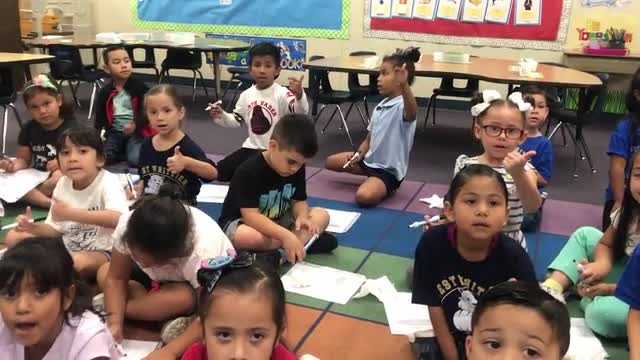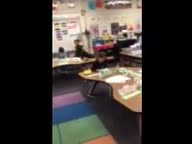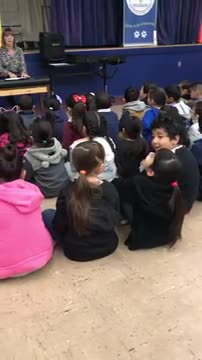MOST POPULAR VIDEOS
- Sort by:
- Most Popular
- Most Recent
Showing all videos (Page 1)
-
 2:27
Homework Help for Spelling Next Week Room 19
2:27
Homework Help for Spelling Next Week Room 19
Hello Families...
Uploaded Sep 28, 2018 by Cindy Cordoza
Happy Friday!!!
Just a reminder...Spelling Homework begins next week. Again, many students may not quite be ready for this. If they can just write the beginning sound that is a start. Please work where they are. Please read comments below:
Here is Room 19 working on CVC (consonant, vowel, consonant) words. This is how you teach them to do their spelling. Copying spelling words from the paper does not help them with phonics development. I will send home a copy of the Elkonin boxes for you to use. Please have a dry erase marker at home for them to use. Thank you for your continued support. -
 2:31
Nursery Rhymes: Please read information below taken from an article by Dr. Jane Williams
2:31
Nursery Rhymes: Please read information below taken from an article by Dr. Jane Williams
What is it about nursery rhymes and children’s stories that are so helpful in developing skills needed for later learning to read?
Uploaded Sep 28, 2018 by Cindy Cordoza
Nursery rhymes are often short and have a great deal of repetition. Repetition offers your growing child the opportunity to tune into words a second and third time and helps him remember what he has just heard. A rhyme’s repetition can also help your child become aware of the individual units of sound, known as phonemes, which make up words.
Nursery rhymes are organied so that similar sounds jump out at you, which doesn’t happen in every day speech. By introducing your child to patterns of sounds, your little one’s brain receives the input it will need to categorise words by their internal structure. This is the precursor to the awareness that letters can represent the sounds of words. So, nursery rhymes help your child’s brain segment words into syllables, hear similarities between words that rhyme or start with the same sounds, and enjoy sound play. Having developed sensitivity to language, children are ready, at age five or six, to think about the sequence of sounds in a whole word, a skill that is crucial for learning to read and spell.
Nursery rhymes can also pave the way for a love of books. They introduce the idea of listening from beginning to end as the narrative develops, however they are short, so your youngster doesn’t have to sit still very long. As she gets older, you can introduce longer stories and those with a real plot.
There are social benefits to nursery rhymes as well. Nursery rhymes are often sung as a group activity, so your baby or child begins to feel part of a social circle that enjoys singing or reciting together. This will help your child connect to other children.
Nursery rhymes link us to the past. Many adults, once they have children, will often be surprised at how many nursery rhymes they remember from their own childhood. There may even be some strong emotional feelings attached to these memories. -
 00:24
St Math
00:24
St Math
Enriching Math Skills with ST Math
Uploaded Dec 11, 2018 by Cindy Cordoza -
 00:31
Happy Dance
00:31
Happy Dance
Last Day Happy Dance
Uploaded Nov 16, 2018 by Cindy Cordoza -
 00:36
Important Foundational Skills
00:36
Important Foundational Skills
Compound Word Blending
Uploaded Sep 28, 2018 by Cindy Cordoza
K-3 Phonological Awareness, Activity Guide 2 Level: Word Syllable Phoneme
Objective: Help students blend two separate words to make a compound word.
Steps
1. Teacher explains that a compound word is made by putting two different words together, for example, basketball is really two words together: basket ● ball.
2. Students listen carefully to the words in each pair.
3. Students extend one hand as they say the first word and the other hand as they say the second word.
4. Students clap as they say the two words together as a compound word.
Suggested Practice Words
I Do
1. Fire ● fly
We Do
2. Rail ● road 3. Key ● board
You Do
4. Sun ● flower 5. Skate ● board 6. Earth ● quake 7. Air ● port
8. Foot ● prints
9. Grand ● mother 10. Sub ● way
11. Under ● ground 12. Dish ● washer 13. Week ● end
14. After ● noon 15. Tooth ● paste
(Clap as you say firefly.)
What next? After they have mastered blending parts of compound words, students are ready to learn to identify the number of syllables in a word. Next time, you can try PA Activity Guide [email protected].
Phonological Awareness: Blending
Written by Jaimi Bird, M.A., CCC-SLP
Enrichment Therapy & Learning Center | Coralville | Des Moines | Reading Tutoring
As shared in my previous two post, phonological awareness is a term that refers to a group of pre-reading skills that are important for literacy and language development. Phonological awareness is the ability to hear sounds that make up words in spoken language. This includes recognizing words that rhyme, deciding whether words begin or end with the same sounds, understanding that syllables and sounds can be manipulated to create new words, and separating words into syllables and into their individual sounds.
Now let’s focus on another stepping stone in phonological awareness: BLENDING! Recognizing that sentences can be broken down into words and that words can be broken down into syllables and phonemes (sounds) is segmenting.
Start blending words at the syllable level.
Start with compound words, such as “rainbow” or “pancake”. Have the written words along with two pictures that will make up the new compound word. Have your child slide the two pictures together while saying the words to make the word. “Rain” + “bow” = Rainbow.
Once your child understands the concept of blending with compound words, move to syllable blending. You can use the same strategy as you did before. Write words on paper and cut them apart into syllables. -
 00:39
Do you know your address
00:39
Do you know your address
Class yay
Uploaded Jan 23, 2019 by Cindy Cordoza -
 00:16
music class Today
00:16
music class Today
today's class
Uploaded Jan 23, 2019 by Cindy Cordoza -
 1:00
Rhyming
1:00
Rhyming
Rhyming Words
Uploaded Oct 01, 2018 by Cindy Cordoza -
 00:55
kiddos
00:55
kiddos
November 16
Uploaded Nov 16, 2018 by Cindy Cordoza -
Music Class
Music
Uploaded Jan 23, 2019 by Cindy Cordoza
